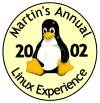 Over the weekend I was ping-ponging back and forth between installations of Mandrake 9.0 and SuSE 8.1–I think a must have done about seven or eight of them in total. During the course of this experience, I learned a number of things:
Over the weekend I was ping-ponging back and forth between installations of Mandrake 9.0 and SuSE 8.1–I think a must have done about seven or eight of them in total. During the course of this experience, I learned a number of things:
- Having your /home directory on a separate disk partition is a good thing. That way, you don’t lose all your personal settings and tweaks when you reformat and reinstall.
- Mandrake 9.0 is much better than SuSE 8.1 about auto-detecting and enabling hardware. Mandrake picked up my PCMCIA wireless network card without any problems, and my MS Intellimouse, too. SuSE needed some twekaing to get both of these going.
- Even if I tell YaST (the SuSE installer) during the hardware detection phase that I’m using a PCMCIA card, I still have to explicitly specify the PCMCIA package and tools in the package selection step, or it won’t install them.
- Even when the PCMCIA tools are installed, I have to manually configure some variables in the file /etc/sysconfig/pcmcia (specifically, PCMCIA_PCIC=”i82365″)
- Although SuSE picks up that I’m using an Intellimouse, it won’t enable the mouse wheel until I’ve manually specified that I want to use the “IMPS/2” driver (in the SaX2 configuration app), and added a line to my .xinitrc file to start up the imwheel service. (All described in /usr/share/doc/packages/imwheel/README, and in various newsgroup postings).
- TrueType font support in KDE3 is much better than in previous versions. I was able to do a very simple import of all of the fonts I use in Windows, and they were available straight away.
- On the other hand, the anti-aliasing and rendering of these fonts is still not as good as on Windows. And there are still far too many different places where you have to configure the fonts to make them work consistently across the system.
- Install the STATIC version of Opera, not the dynamically linked one. Trying to install the dynamic version leads straight into Dependency Hell.
- Double-clicking on a shell script in Konqueror will run the file rather than fire it up in a text editor. Obviously. (Even though it’s still just a text file…)
- The .xinitrc shell script restarts the X server. Obviously. Don’t double-click it, thinking that it will open up in a text editor instead. When you still have work unsaved. Arse.
- KBear is a nice, graphical FTP client. That’s my replacement for WS-FTP sorted.
- KMail is an elegant replacement for Outlook Express, and it will even import messages and folders from an OE message store. Unfortunately it doesn’t import the OE folder hierarchy. Also unfortunately, you can’t drag and drop folders into other folders. So I spent a long time going into each folder’s preferences, and setting its parent folder from a drop-down list.
- I’m still looking for a replacement for my favourite text editor (TextPad), though. Emacs and vi are just silly, unless you either a) enjoy the pain of obscure user interfaces, or b) have worked with them for long enough that you don’t notice the pain any more. jEdit looks like it’ll work, until I find something better.
I have a lot more to explore, but for the moment, the system feels moderately comfortable. It will definitely take a lot more tweaking to get me completely happy with it. Whether I stick with it this year will depend on how quickly I get too frustrated with all the effort that goes into tweaking…